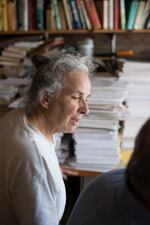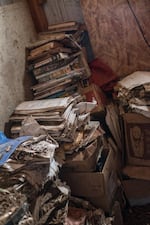
Carol Van Strum has been in legal battles with the federal government and chemical industries since the 1970s. She amassed a trove of government documents, which are now being published for the first time.
Courtesy of Risa Scott / RF Scott Imagery
Bending a rusted, gnarled piece of wire gate just above her head, Carol Van Strum ducked into the old, dark shed where she kept some old, dark secrets.
"This was my bear deterrent," she said of the makeshift gate.
She shined a lantern past a stack of hay bales, lighting up a row of decaying cardboard boxes that housed what's left of her document trove.
"This is where the worst of them were," she said. "This whole, it was just filled. And you can see the state of them. This is what they all looked like."
After gathering dust, rust and rat poop for decades in the Siuslaw National Forest, Van Strum's piles of documents about the chemical industry are poised to become evidence in lawsuits with billions of dollars at stake.
Van Strum, 76, spent the past 40 years involved in various lawsuits against the federal government and chemical manufacturers.
The records she compiled are now being published in a searchable online archive known as the Poison Papers, which has begun drawing the attention of researchers and attorneys across the country. That includes the Washington Attorney General's office and attorneys for the cities of Seattle, Spokane, Portland and several others who are suing the agrochemical company Monsanto over widespread contamination from a group of chemicals known as PCBs.
Explore some of the documents unearthed from Carol Van Strum's barn:
The documents, which cover a range of topics including PCBs and herbicides, detail flaws with laboratory testing, efforts to conceal chemical science and the "extraordinary influence" of chemical manufacturers on regulators at the U.S. Environmental Protection Agency, according Lisa Graves at the Center for Media and Democracy, which funded the Poison Papers project.
"They show in many ways, that public health has not been protected, " Graves said of the documents. "We wanted to create a resource the public could use when trying to understand the failings or problems with the way the EPA might be captured by industry."
In some cases, Van Strum preserved documents the government likely threw away long ago -- a trove of evidence, amassed somehow by a former bookstore owner and orchardist in rural Oregon.
It began in the early 1970s, when Van Strum's family saw an ad in the San Francisco Chronicle and moved to a farm in the Siuslaw National Forest.
Soon after, she said, they were sprayed by a helicopter with 2,4,5-T -- a component of Agent Orange -- that was meant to treat a timber crop on nearby public land.
She banded together with neighbors, sued and won an injunction to stop the spraying.
That was just the beginning of her environmental, anti-chemical activism. Nobody even knew to call it that at the time, she said.
Her environmental fight outlasted two marriages. It helped carry her after a personal tragedy.
In 1978, her home caught fire and burned to the ground, killing her four daughters. Investigators never determined the cause of the fire.
Van Strum never really rebuilt. She now lives in what's left of the barely insulated garage, surrounded by books and a few cages for her birds.
"I mean, I was a mess. But I guess I just kept on going, I don't know," she said.
She poured herself into activism, writing a book about it in 1983.
She became involved in lawsuits against the U.S. Environmental Protection Agency and the Air Force, Dow and Monsanto. Today, she's part of an effort to ban aerial spraying in Lincoln County, also headed to trial.
The documents overtook Van Strum's life. They buckled the floor of a covered wooden bridge she used as a barn.
Recently, through Van Strum's writing, national advocacy groups began to notice what she had. The Bioscience Resource Project and the Center for Media and Democracy offered to help her digitize her collection.

Documents gather dust in decaying boxes in Carol Van Strum's shed in the Siuslaw National Forest. For decades, Van Strum has been amassing documents about the chemical industry through lawsuits and Freedom of Information Act requests.
Courtesy of Risa Scott / RF Scott Imagery
It was like a weight has been lifted: "A huge weight. It turned out to be three tons!"
They helped Van Strum clean and scan the old, stained papers. She scraped rat poop off some. Others were wet. She dried them in the oven.
"Helping pull staples, that was the worst, all these rusty staples," she said.
Weeks after the archive went public, some of the documents could become evidence in a group of lawsuits against Monsanto.
Van Strum's collection included records from Monsanto and the federal government regarding a group of chemicals known as PCBs, which were widely used in things like electrical equipment.
The chemicals were eventually banned, and still contaminate many waterways such as the Willamette and Duwamish rivers.
In December, Washington became the first state to sue Monsanto over PCB contamination, alleging the company sold a product it knew was harmful and would contaminate the environment.
Bill Sherman, assistant attorney general for the State of Washington, said he was reviewing the new documents and expected they would be involved in the state's lawsuit against Monsanto.
"They confirm that Monsanto was aware of the harms that their PCBs were causing and continued to sell them without telling the public or their customers," Sherman said of the documents.
Seattle, Spokane, Portland and several other cities also have similar suits against the company. Altogether, the claims could be worth billions of dollars. John Fiske, outside counsel for the many parties suing Monsanto, said his team had already turned up most of the same documents he found reviewing Van Strum's archive.
Monsanto denies liability for the contamination, saying scientific literature supported the production of PCBs provided certain safety measures were taken, and that the company voluntarily stopped production ahead of federal requirements.
"At the time Monsanto manufactured PCBs, they were a legal and approved product used in many useful applications," said Scott Partridge, vice president of strategy at Monsanto. "Monsanto has no liability for pollution caused by those who used or discharged PCBs into the environment."
Van Strum's documents also offer a glimpse into the inner workings of the EPA, an agency currently under scrutiny for its lacking transparency and increasingly close ties to the industries it regulates. A spokesman for the EPA did not respond to requests for comment.
Reporter Sharon Lerner wrote about Van Strum's work for The Intercept. She sees a through line between the EPA in those old records and the one she covers today.
"You realize there's an incredibly well-orchestrated and incredibly well-funded campaign that's been going on for decades to get these things sold and keep them profitable," Lerner said. "What changes, I think, is how much effort and how much the counterforce is against that."
For 40 years, Van Strum tried to be that counterforce when she thought the government wasn't.
She said she felt like a mouse, emptying a silo one grain at a time. She's now eager to see others build on her efforts.
"Anybody can use them, anybody," she said. "It's not up to me anymore. Yes!"
